Overview
This article shines a light on the essential behavior intervention strategies that every parent should be aware of to effectively manage their children's behaviors, especially those diagnosed with autism and ADHD. Understanding the unique challenges you face, it emphasizes the importance of tailored approaches.
Techniques include:
- Positive reinforcement
- Setting clear expectations
- Collaborating with educators
Supported by research and case studies, these strategies demonstrate their effectiveness in fostering positive behavior changes and enhancing your child's overall development. As you navigate this journey, remember that you are not alone; there are resources and support available to help you every step of the way.
Introduction
In the journey of child development, behavior intervention strategies hold a vital place, particularly for children diagnosed with autism and ADHD. These thoughtful approaches, grounded in Applied Behavior Analysis (ABA), are designed to enhance specific behaviors while addressing the unique complexities of each child's needs.
With many children facing dual diagnoses, the need for tailored interventions has never been more pressing. As parents navigate this intricate landscape, grasping the principles of behavior management—ranging from identifying root causes to utilizing positive reinforcement—becomes essential.
This article explores effective strategies that not only encourage positive behavior changes but also cultivate a nurturing environment for children to flourish. It underscores the significance of collaboration among parents, educators, and professionals in this critical journey.
Understanding Behavior Intervention Strategies
Behavior intervention strategies are organized approaches designed to enhance specific actions in children, especially those diagnosed with autism and ADHD. These strategies, rooted in the principles of Applied Behavior Analysis (ABA), underscore the importance of understanding behaviors within their context. By implementing these techniques, parents can cultivate structured environments that not only encourage positive behavior changes but also minimize challenging actions.
Recent statistics reveal that between 13% and 22% of children diagnosed with ADHD also meet the criteria for autism spectrum disorder (ASD). This highlights the urgent need for effective behavior intervention strategies tailored to this dual diagnosis. Experts emphasize the importance of strategies that consider each child's unique needs and circumstances. As Dr. Wun Jung Kim observes, "Though evidence of this overlap had been documented for many years, the fifth revision of the Diagnostic and Statistical Manual of Mental Disorders (DSM-5) lessened barriers for clinicians to make dual diagnoses of ASD and ADHD."
The effectiveness of behavior intervention strategies, particularly ABA, in improving children's behavior is well-documented. Numerous studies have shown its capacity to foster significant improvements in social skills, communication, and adaptive behaviors. However, a scoping review of existing ABA research has uncovered limitations, such as the broadness of outcome measures and potential biases in study designs. This reveals the need for more standardized methodologies and clearer definitions within the field to ensure that findings are relevant and beneficial for children with ASD and their families.
As we look toward 2025, the landscape of behavior intervention strategies is evolving. Recent approaches are focusing on integrating technology and data-informed methods to enhance therapy outcomes. Advocacy efforts are underway to improve access to therapy services for individuals with autism through insurance reform and increased public funding—essential steps for parents seeking effective solutions.
Successful case studies illustrate the application of ABA therapy in home environments, demonstrating how behavior intervention strategies can lead to meaningful changes in behavior. By familiarizing themselves with these strategies, parents can take the first step toward effective behavior management at home, ultimately unlocking their children's potential and nurturing a supportive atmosphere for growth. For additional support and information, consider subscribing to Autism Parenting Magazine, which aligns with the mission of ASD Media.
Identifying the Root Causes of Behavior
Successfully navigating challenging behaviors in children requires a deep understanding of the reasons behind their actions. These behaviors can stem from various factors, such as sensory sensitivities, emotional distress, or unmet needs. To gain valuable insights, parents are encouraged to observe their children's behavior in different contexts, taking note of any patterns or triggers that arise.
This careful observation is crucial, as it allows parents to tailor interventions to meet their children's unique needs, ultimately leading to more positive outcomes.
For example, if a child consistently acts out during transitions, it may indicate anxiety related to change rather than simple defiance. Recent studies reveal that sensory sensitivities can significantly influence behavior, with many children showing heightened reactions to sensory stimuli. Understanding these sensitivities is essential for parents and caregivers, as it can guide strategies that reduce discomfort and foster positive behavior.
Additionally, statistics indicate that lower income levels are often linked to a higher likelihood of receiving diagnoses of ASD and ADHD, underscoring the necessity for accessible resources and support for families facing these challenges. As Benjamin Zablotsky, PhD, notes, "These findings highlight the complexity of individuals diagnosed with both ADHD and ASD." A 2021 case study illustrates the critical role of primary care providers in managing ADHD, particularly for children on Medicaid, who may have limited access to specialists.
This emphasizes the importance of early identification and intervention in effectively addressing behavioral issues.
Understanding prevalence—defined as the number of individuals with a condition in relation to the total population—is vital for grasping the impact of ASD and ADHD on families. By recognizing the common factors influencing behavior in children with autism and ADHD, such as sensory processing challenges and difficulties with emotional regulation, parents can implement targeted behavioral evaluations. These evaluations help identify specific triggers and develop personalized strategies that nurture their children's growth and development.
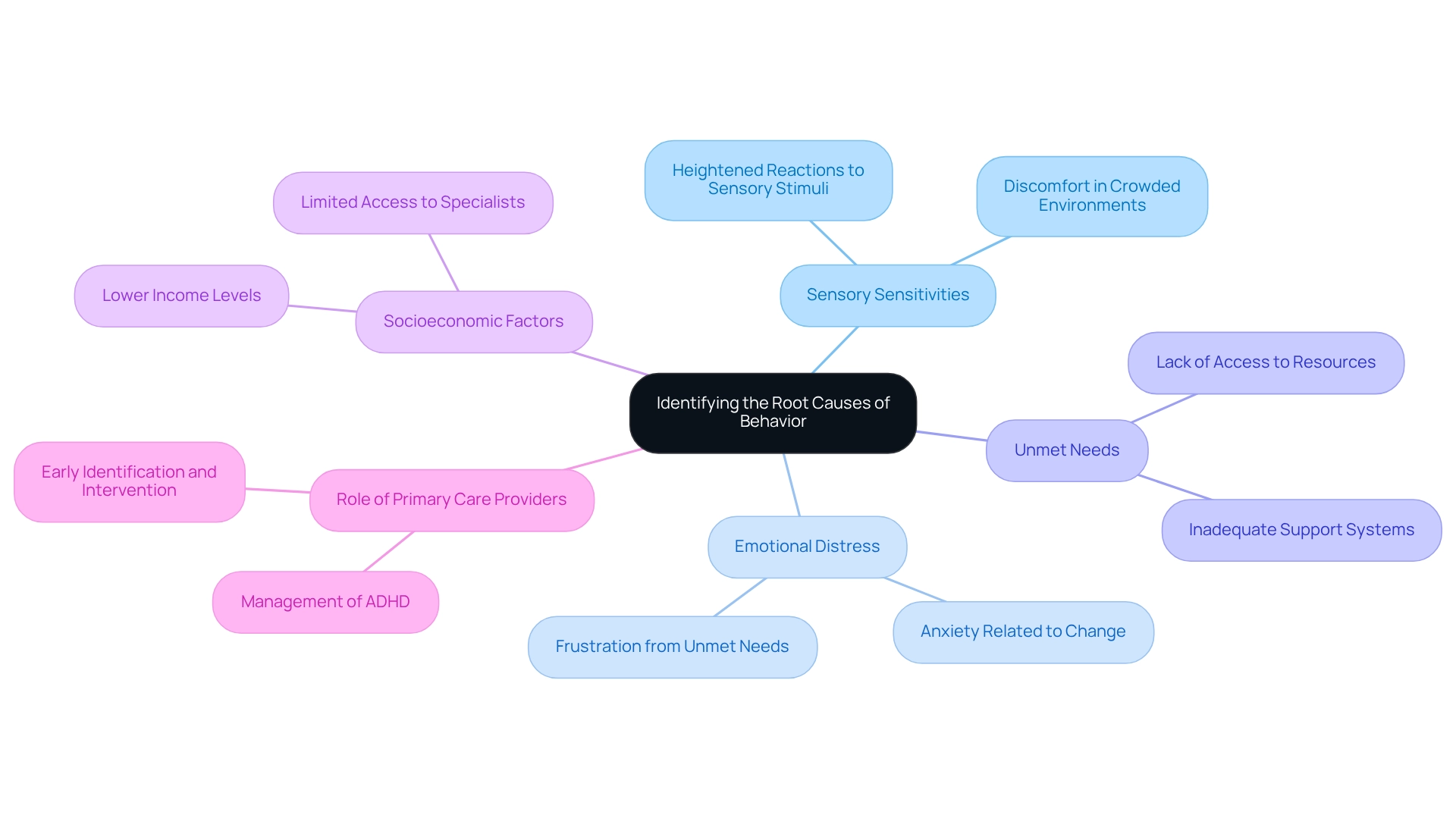
The Power of Positive Reinforcement
Positive reinforcement is a powerful approach that involves rewarding desired actions to encourage their recurrence. This can take various forms, such as verbal praise, tangible rewards, or special privileges. For example, when a child completes their homework independently, a parent might reward them with extra playtime.
This method not only strengthens the desired behavior but also fosters a closer parent-child relationship.
Research shows that children are more receptive to positive reinforcement than punitive actions, illustrating the effectiveness of behavior intervention strategies for long-term behavior change. One study found that children exposed to behavior intervention strategies that included positive reinforcement exhibited significantly improved behavioral outcomes compared to those subjected to punishment. In fact, statistics indicate that positive reinforcement can lead to a 30% increase in preferred behaviors over time.
You can see successful applications of positive reinforcement in various settings, including schools and home life. Educators often implement reward systems to motivate students, which have been shown to enhance engagement and academic performance. Specialists in youth behavior intervention emphasize the importance of using rewards to promote positive actions, noting that consistent reinforcement can lead to lasting changes in behavior.
As Sari & Indian state, "In order to reinforce desired conduct in pupils, it is a good idea to provide them with positive reinforcement."
Effective techniques for positive reinforcement include setting clear expectations, providing immediate feedback, and varying the types of rewards to maintain interest. For instance, a sticker chart can visually track progress, while verbal praise can acknowledge specific achievements. Recent findings suggest that blending intrinsic and extrinsic rewards can further boost motivation and self-efficacy in children.
Case studies focusing on children with autism have demonstrated the effectiveness of behavior intervention strategies, particularly positive reinforcement techniques, in encouraging preferred actions and reducing challenging behaviors. These approaches not only improve behavior but also contribute to the overall well-being of children, making them invaluable resources for parents and caregivers. Additionally, we must not overlook the importance of mental health support for caregivers, especially female caregivers, particularly given that 25% of healthcare workers reported substance use during the COVID-19 pandemic.
This highlights the need for supportive environments that empower caregivers in their roles.
Moreover, interprofessional collaboration in modification plans has been shown to enhance healthcare quality and outcomes for patients, clients, families, and caregivers, underscoring the significance of collaborative approaches in management.
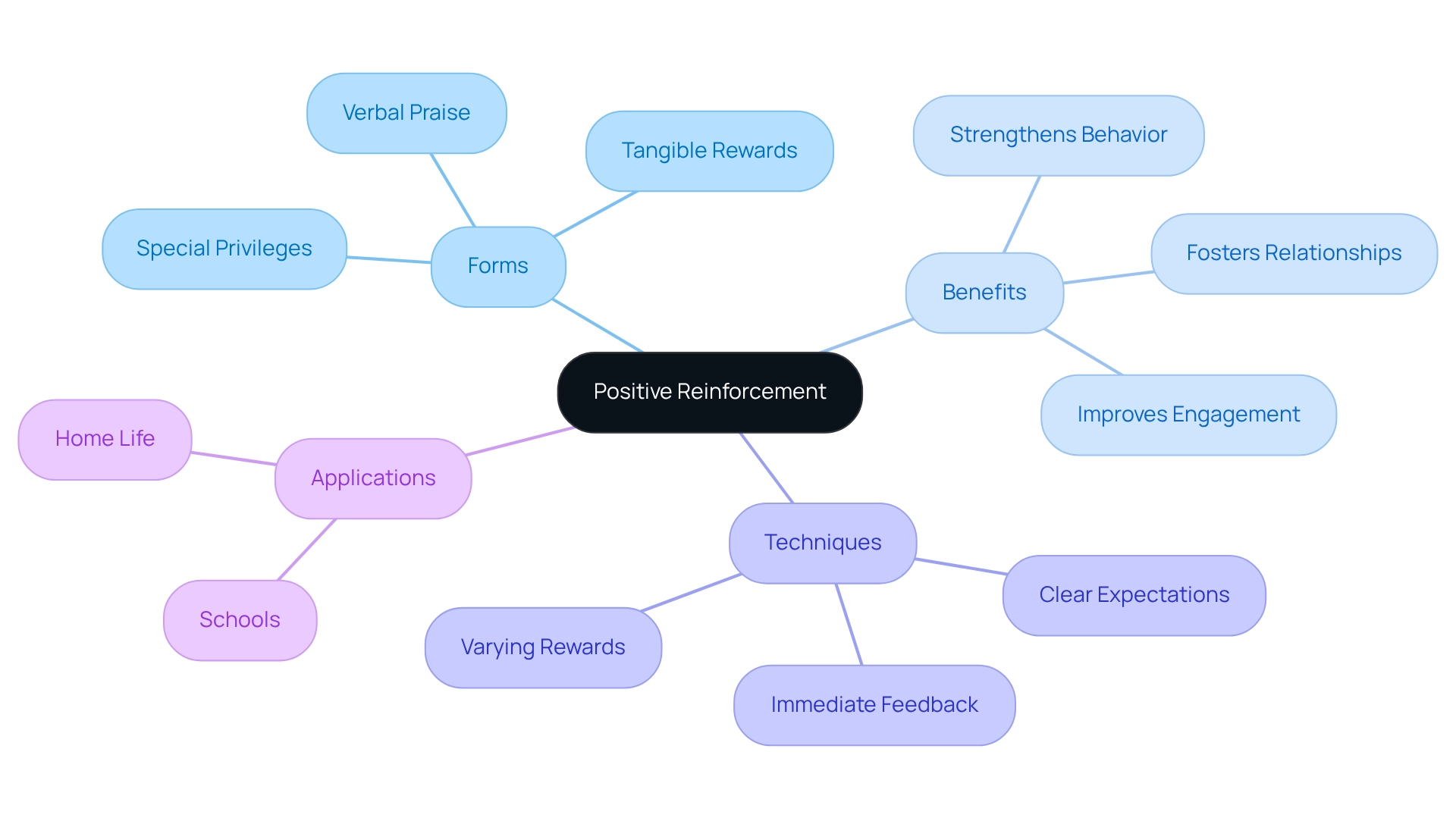
Establishing Clear Expectations and Rules
Establishing clear expectations and guidelines is vital for effective behavior intervention strategies aimed at managing conduct in youth, particularly those with autism and ADHD. Parents are encouraged to articulate specific, observable, and measurable expectations. For instance, rather than a vague directive like 'be good,' a more precise instruction would be, 'please use your indoor voice while we are in the house.' This clarity helps young individuals understand exactly what is expected of them.
Visual aids can significantly enhance understanding, especially for individuals with autism. Presenting rules in a visual format—such as charts or pictures—reinforces comprehension and acts as a constant reminder of the expectations. Research indicates that consistently applying these guidelines not only supports learning but also fosters a sense of safety and predictability, which is crucial for emotional management.
Moreover, engaging young individuals in conversations about conduct expectations can nurture a shared commitment to maintaining a positive environment. A case study titled 'Engaging Students in Behavior Expectations' demonstrates how this approach resulted in fewer disruptions and discipline incidents while simultaneously improving academic performance. By fostering confidence and support among students, this initiative illustrated the power of collaboration in managing conduct, particularly for children with autism and ADHD.
Statistics reveal that consistent expectations can alleviate emotionally charged situations, particularly in educational settings. This underscores the importance of clear communication in behavior intervention strategies for conduct management. As Jamie S. Salter, an author, wisely states, 'Regardless of where or how they are receiving their instruction, it is our responsibility to systematically teach classroom expectations so that students can be successful learners.'
Furthermore, effective self-management systems require thoughtful pre-planning and assessment of various logistical elements, which are essential for successfully implementing management approaches. By establishing clear guidelines and consistently communicating them, parents can significantly enhance their children's conduct and overall development.

Maintaining Consistency in Interventions
Consistency is crucial in intervention strategies, especially for individuals with autism. Parents should implement the same rules and consequences across various situations to eliminate confusion and foster understanding. For instance, if a child receives praise for completing chores one day but not the next, they may struggle to grasp what is expected of them. This inconsistency can lead to uncertainty and hinder their ability to learn effectively.
Research suggests that behavior intervention strategies offer a consistent method that not only clarifies expectations but also enhances the connection between actions and consequences, which is essential for altering conduct. A study on conduct interventions revealed that modifications were predominantly fidelity-consistent, underscoring the importance of deliberate and consistent application of rules. The research assessed the fidelity-consistency of modifications in parenting programs and found that deliberate reasoning on modifications is vital for sustaining fidelity-consistent evidence-based practices.
Unreliable guidelines can result in behavioral issues, as young individuals may not comprehend the limits established for them. Experts in the field emphasize that maintaining consistent rules and consequences is vital for effective conduct management. For instance, analysts often emphasize that youngsters flourish in settings where expectations are distinct and steadfast. This consistency aids young ones in assimilating the link between their actions and the results, fostering improved decision-making.
Shawn Young, SVP of Product Management and Strategy, notes that "not all tech is created equal," emphasizing the need for purposeful approaches in educational settings, which can also apply to behavior management at home.
To maintain consistent rules and consequences, parents can adopt several strategies:
- Clearly communicate expectations and consequences to the child.
- Use visual aids, such as charts or schedules, to reinforce rules.
- Regularly review and discuss the rules with the young one to ensure understanding.
- Be consistent in applying consequences, whether they are rewards or disciplinary actions.
Case studies have indicated that families who apply consistent conduct modification techniques report enhanced results in their offspring's actions. A consistent approach in the classroom promotes a positive community by eliminating favoritism and discrimination, leading to better relationships among students and with the teacher. By fostering an environment of predictability, parents can significantly enhance their child's ability to navigate social situations and develop essential skills.
Ultimately, the significance of consistency in conduct interventions cannot be overstated; it is a foundational element that supports effective learning and positive change in actions.
Teaching Replacement Behaviors
Teaching replacement actions is a vital strategy in conduct management, emphasizing behavior intervention strategies that identify and promote suitable alternatives to unwanted actions. Imagine a child who frequently screams for attention; in such cases, parents can gently guide them to raise their hand or use a specific phrase to request help. This approach not only reduces undesirable actions but also nurtures the development of functional communication skills, essential for positive social interactions.
To effectively instruct these alternative actions, parents can demonstrate the desired practices and create opportunities for practice in various situations. Consistent reinforcement is crucial; by encouraging your child to use these new skills regularly, they can transform into ingrained habits. Studies suggest that behavior intervention strategies focused on teaching alternative behaviors can significantly diminish conduct issues in youth. Stoiber emphasizes this point, noting a considerable and meaningful effect of these strategies on behavior problems in young individuals.
Moreover, statistics indicate that 38 (50.67%) of the experimental designs employed multiple baseline, providing empirical evidence for the efficacy of these approaches.
Insights from child psychologists further highlight the importance of tailoring communication strategies to each child's unique needs. Utilizing visual aids or social stories can enhance understanding and engagement. A systematic review conducted by Tyler E Smith and associates on self-management strategies has shown encouraging outcomes in reducing difficult actions among school-age students, further endorsing the effectiveness of behavior intervention strategies that include teaching functional communication skills.
Additionally, the case study titled "Methodological Rigor in Self-Monitoring Reviews" underscores the importance of high-quality methodologies in understanding the effectiveness of self-monitoring interventions, which can relate to teaching replacement behaviors.
Incorporating these techniques not only addresses immediate behavioral concerns but also empowers young individuals with the tools they need to express themselves appropriately. This paves the way for improved social interactions and overall development, fostering a brighter future for your child.
Utilizing Visual Supports for Clarity
Visual aids serve as invaluable resources for enhancing comprehension and communication among youth with autism and ADHD. These supports can take various forms, such as charts, pictures, and schedules that clearly outline daily routines and expectations. For instance, implementing a visual schedule allows children to anticipate transitions throughout their day, significantly reducing anxiety and resistance to change.
Research shows that visual aids not only enhance comprehension but also foster a sense of control and engagement in learning environments. A study titled 'Utilization of Visual Supports in Educational Settings' highlights the practical benefits of these tools, demonstrating that their integration with established classroom management strategies can lead to improved on-task behaviors. The findings suggest that children utilizing visual supports experience greater enjoyment in their learning, underscoring the importance of these aids in support strategies. However, it’s crucial to acknowledge the study's limitations, including a small sample size and the lack of a control group, which may impact the generalizability of the results.
Statistics reveal that interventions incorporating video modeling, a specific form of visual assistance, have shown promising outcomes. Four essential elements have been recognized as effective in improving behavior management. Educators have noted the transformative influence of visual aids. One educator shared, "Not everything worked, but I have ideas of other ways and places to use visual supports," illustrating the adaptability and potential of these tools in various contexts.
As parents explore the latest tools for visual aids in behavior management, it's essential to consider different types of visual supports that can enhance intervention strategies. These may include visual schedules, social stories, and graphic organizers, all tailored to meet the unique needs of young individuals. Expert insights stress the importance of customizing visual supports to individual characteristics and settings, ensuring that behavior intervention strategies effectively benefit each child.
Moreover, further investigation through larger studies is vital to validate the effectiveness of these strategies and explore their impact across diverse populations. By utilizing visual aids, parents can create a structured and nurturing environment that encourages positive conduct and learning outcomes. Together, let’s embrace these tools to support our children’s growth and development.
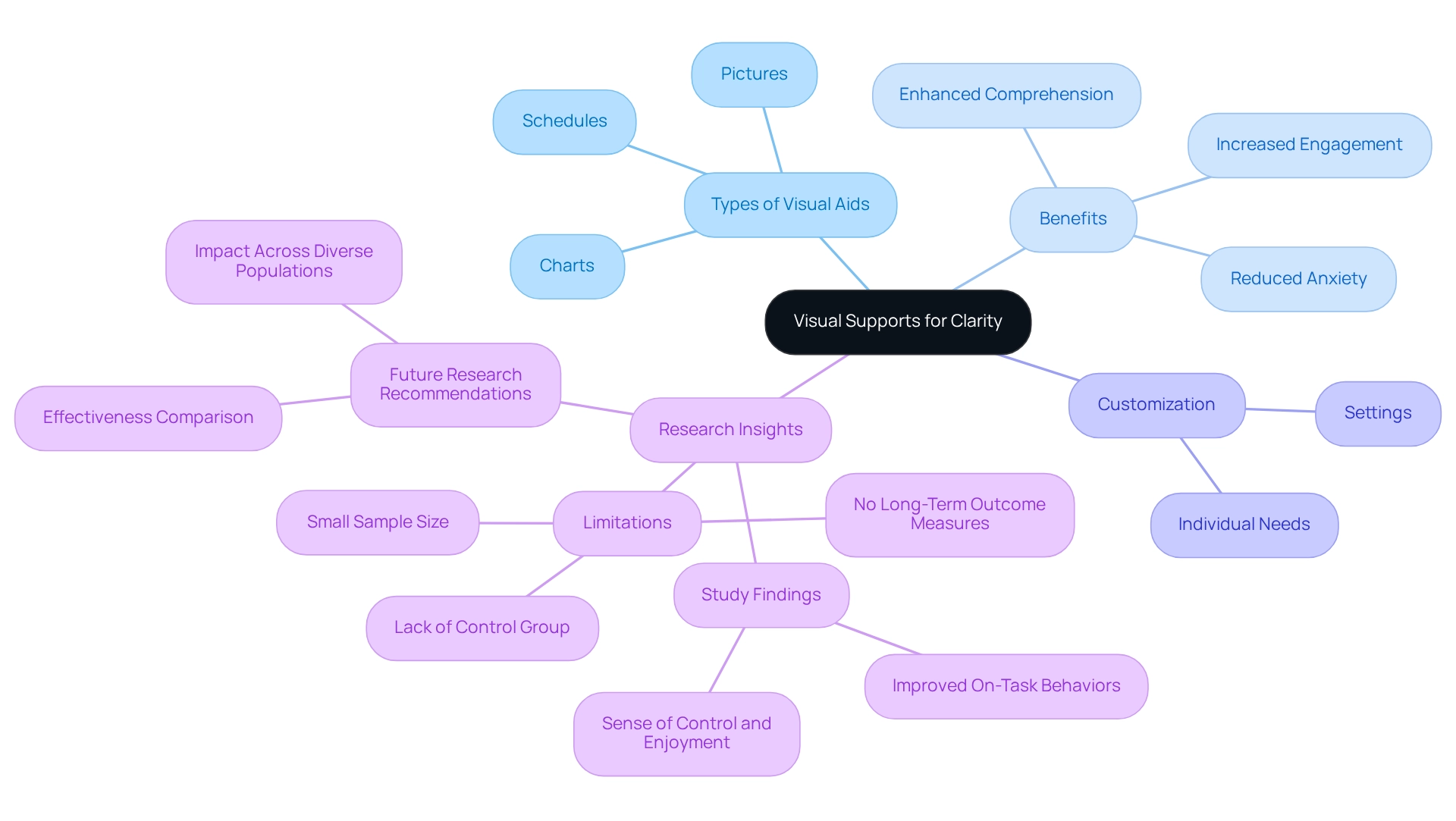
Collaborating with Educators and Professionals
Cooperation with educators and other specialists is essential for effective intervention. Parents are encouraged to prioritize regular communication with teachers and therapists, sharing insights and strategies that work both at home and in school. This unified approach ensures that young individuals receive consistent messages about behavior across various settings, which is vital for their growth.
Research indicates that students who engage in discussions about their school courses with their parents have a 44% greater chance of pursuing post-secondary education. This statistic underscores the significance of parental involvement in educational environments.
Establishing regular meetings and maintaining open lines of communication can foster a supportive network that greatly enhances a young person's learning and behavioral outcomes. Insights from youth behavior experts reveal that effective communication between parents and educators not only cultivates a collaborative atmosphere but also leads to improved behavior management techniques. Additionally, a recent survey found that 57.5% of senior high school students strongly agree that strong parental involvement correlates with high academic performance, highlighting the motivational impact of such engagement.
As Courtney A. Zulauf-McCurdy notes, despite the focus on parent-teacher relationships, there is a pressing need for more effort aimed at identifying and applying practical methods to strengthen these connections. By working together, parents and educators can develop tailored strategies to address specific behavioral challenges, ultimately enhancing the youth's overall development and achievement. This collaborative effort aligns with ASD Media's mission to foster a supportive community that enhances the implementation of ABA therapy.
Monitoring and Evaluating Intervention Effectiveness
Overseeing and assessing the effectiveness of support strategies is essential for tailoring approaches that meet a child's unique needs. Parents can utilize various data-gathering techniques, such as charts, logs, and digital tools, to systematically track specific actions and the outcomes of strategies over time. Research shows that a structured method for data collection can greatly enhance understanding of changes in behavior.
Importantly, a classification of delivery modes has been developed, identifying 39 items across four levels of effectiveness. This resource can guide parents in selecting the most suitable methods for their child's requirements.
Moreover, the ongoing development of a 'Behavior Change Ontology' aims to systematically illustrate and connect elements of modification efforts, enhancing understanding of what truly works in behavior change. By analyzing the data collected, parents can identify behavioral patterns, evaluate progress, and make informed adjustments to their strategies. For instance, case studies indicate that digital methods can effectively complement traditional face-to-face approaches, providing deeper insights into a young person's behavior in various settings, including schools and clinics.
This dual approach not only enriches the data available but also promotes a more comprehensive understanding of the young person's development.
Regular assessment of strategies helps maintain focus on the young person's goals and encourages continuous improvement. Experts in the field stress the importance of data collection in monitoring progress. As EC noted, 'consistent monitoring can lead to more effective behavior management strategies.'
By employing these techniques, parents can ensure that their actions are not only effective but also adaptable to the evolving needs of their children.
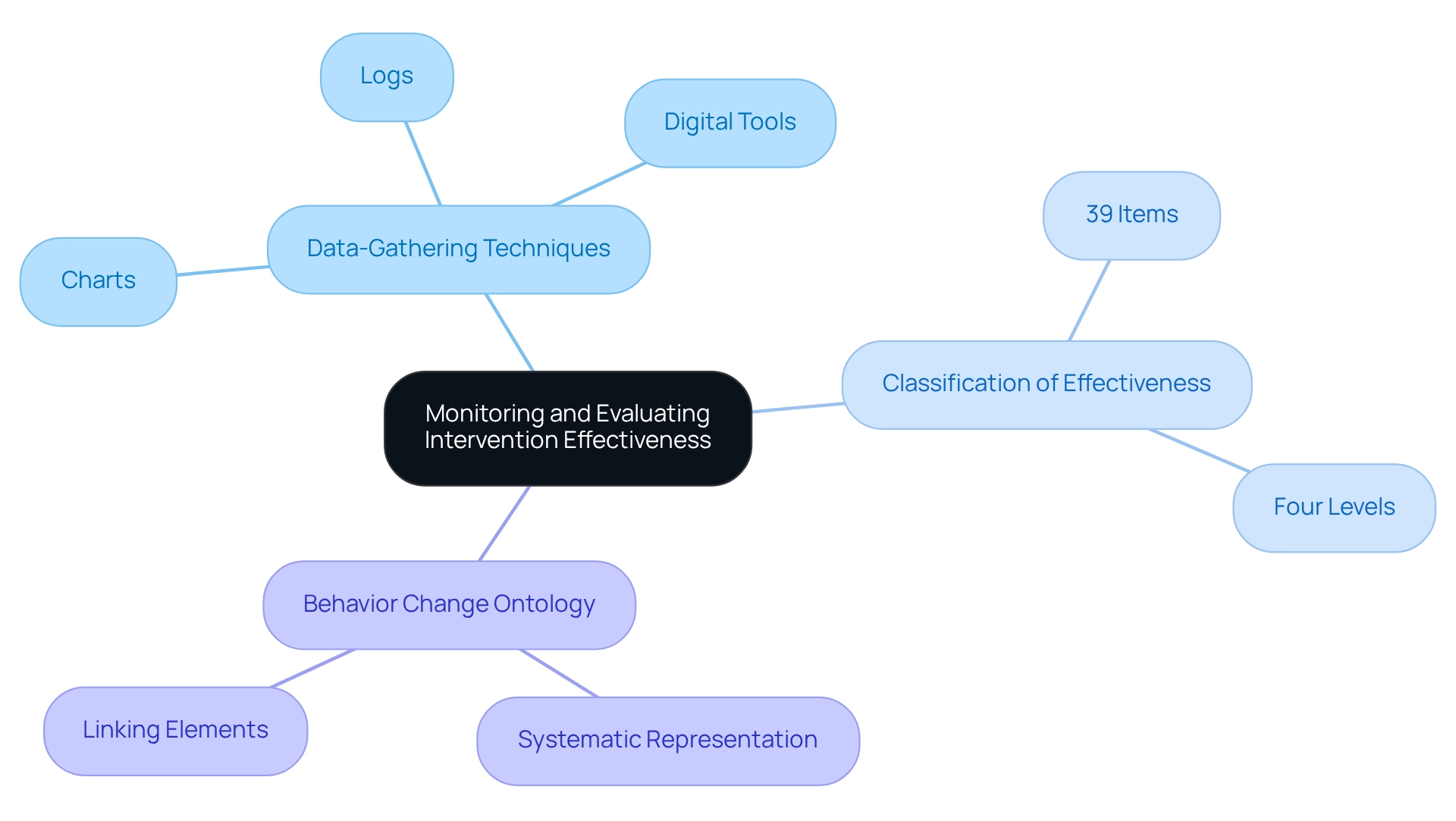
Adapting Strategies to Meet Changing Needs
Adapting behavior intervention strategies to meet the evolving needs of our youth is vital for their continued success. As children grow, their developmental stages bring about shifts in behaviors and needs, which calls for a flexible approach from parents. This adaptability may involve introducing new strategies, modifying reinforcement techniques, or seeking additional professional support as challenges emerge.
Research highlights that interventions should be sensitive to developmental stages, underscoring the significance of parental involvement and the integration of interactive techniques. Notably, collaboration among professionals has been shown to enhance the quality of health care and outcomes for patients, clients, families, and caregivers, emphasizing the importance of working together in managing behavior. For instance, case studies outlined in "Interprofessional Team Strategies in Behavioral Modification" illustrate how improved communication and teamwork among caregivers can lead to significantly better outcomes.
Moreover, statistics reveal that the SSBIC for the conditional model of externalizing problems stands at 36819.131, reinforcing the need to adapt behavior strategies in line with an individual's growth trajectory. By remaining responsive and open to change, parents can ensure that their interventions not only stay effective but also nurture their child's overall development, ultimately creating a supportive environment that encourages positive behavioral changes.
As you navigate this journey, remember that you are not alone. Share your experiences and insights, and let’s support each other in fostering the best for our children.
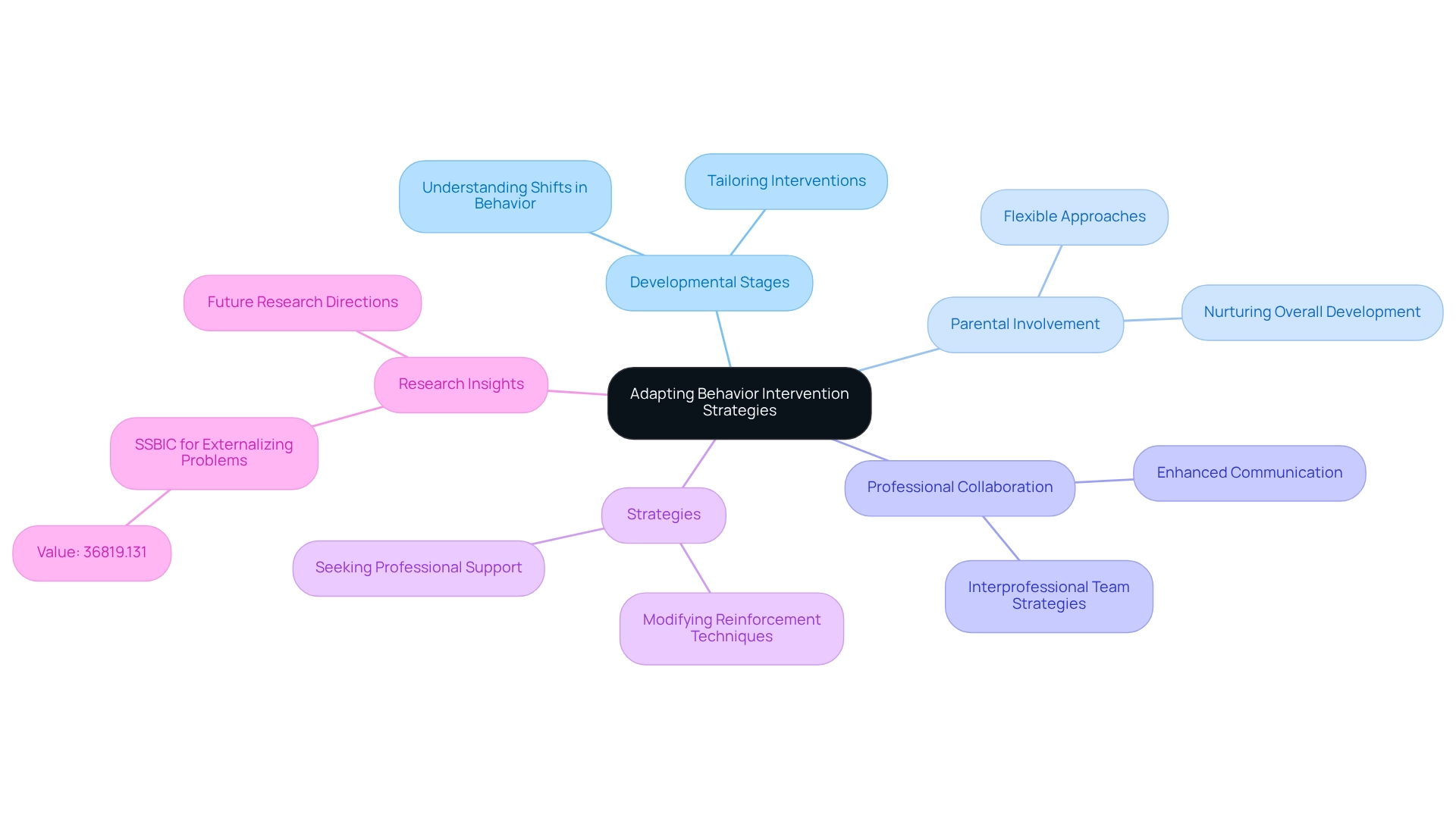
Conclusion
Behavior intervention strategies play a crucial role in nurturing the development of children diagnosed with autism and ADHD. By understanding the principles of Applied Behavior Analysis (ABA) and implementing tailored strategies, parents can create structured environments that not only encourage positive behaviors but also address challenges. It is vital to identify root causes, utilize positive reinforcement, and establish clear expectations, as these elements form the foundation for effective behavior management.
Collaboration among parents, educators, and professionals is essential for fostering a cohesive approach to behavior intervention. Regular communication and shared strategies enhance the effectiveness of interventions, ensuring that children receive consistent support across various settings. Moreover, monitoring and evaluating the effectiveness of these strategies allow for ongoing adjustments that cater to the evolving needs of each child.
Ultimately, the journey of behavior management is one of adaptation and responsiveness. By remaining flexible and open to change, parents can ensure that their interventions not only address immediate behavioral concerns but also promote long-term growth and development. As children navigate their unique paths, the collective efforts of families and professionals can lead to meaningful improvements in behavior, communication, and social skills, paving the way for a brighter future. Together, let us continue to support each other on this journey, sharing experiences and resources that can make a difference.
Frequently Asked Questions
What are behavior intervention strategies?
Behavior intervention strategies are organized approaches designed to enhance specific actions in children, particularly those diagnosed with autism and ADHD, by understanding behaviors within their context and implementing techniques to encourage positive behavior changes.
Why is there a need for effective behavior intervention strategies for children with dual diagnoses of ADHD and autism?
Statistics show that between 13% and 22% of children diagnosed with ADHD also meet the criteria for autism spectrum disorder (ASD), highlighting the urgent need for tailored behavior intervention strategies that consider each child's unique needs and circumstances.
How effective are behavior intervention strategies based on Applied Behavior Analysis (ABA)?
ABA-based behavior intervention strategies are well-documented for improving children's behavior, including significant improvements in social skills, communication, and adaptive behaviors, although some studies have noted limitations in outcome measures and potential biases.
What advancements are being made in behavior intervention strategies?
Recent approaches are focusing on integrating technology and data-informed methods to enhance therapy outcomes, along with advocacy efforts aimed at improving access to therapy services for individuals with autism.
How can parents effectively navigate challenging behaviors in their children?
Parents are encouraged to observe their children's behavior in different contexts to identify patterns or triggers, which can help tailor interventions to meet their unique needs and lead to more positive outcomes.
What role do sensory sensitivities play in children's behavior?
Sensory sensitivities can significantly influence behavior, with many children showing heightened reactions to sensory stimuli. Understanding these sensitivities can guide strategies that reduce discomfort and foster positive behavior.
What is the importance of early identification and intervention for behavioral issues?
Early identification and intervention are critical for effectively addressing behavioral issues, especially for children on Medicaid who may have limited access to specialists.
How does positive reinforcement work in behavior intervention?
Positive reinforcement involves rewarding desired actions to encourage their recurrence, which can include verbal praise, tangible rewards, or special privileges, thereby strengthening the desired behavior and fostering a closer parent-child relationship.
What are the benefits of using positive reinforcement in behavior intervention?
Research shows that positive reinforcement is more effective than punitive actions, leading to a significant increase in preferred behaviors over time and enhancing engagement and performance in various settings.
What techniques can enhance the effectiveness of positive reinforcement?
Effective techniques include setting clear expectations, providing immediate feedback, varying rewards, and using visual tracking methods, such as sticker charts, to maintain interest and motivation in children.




